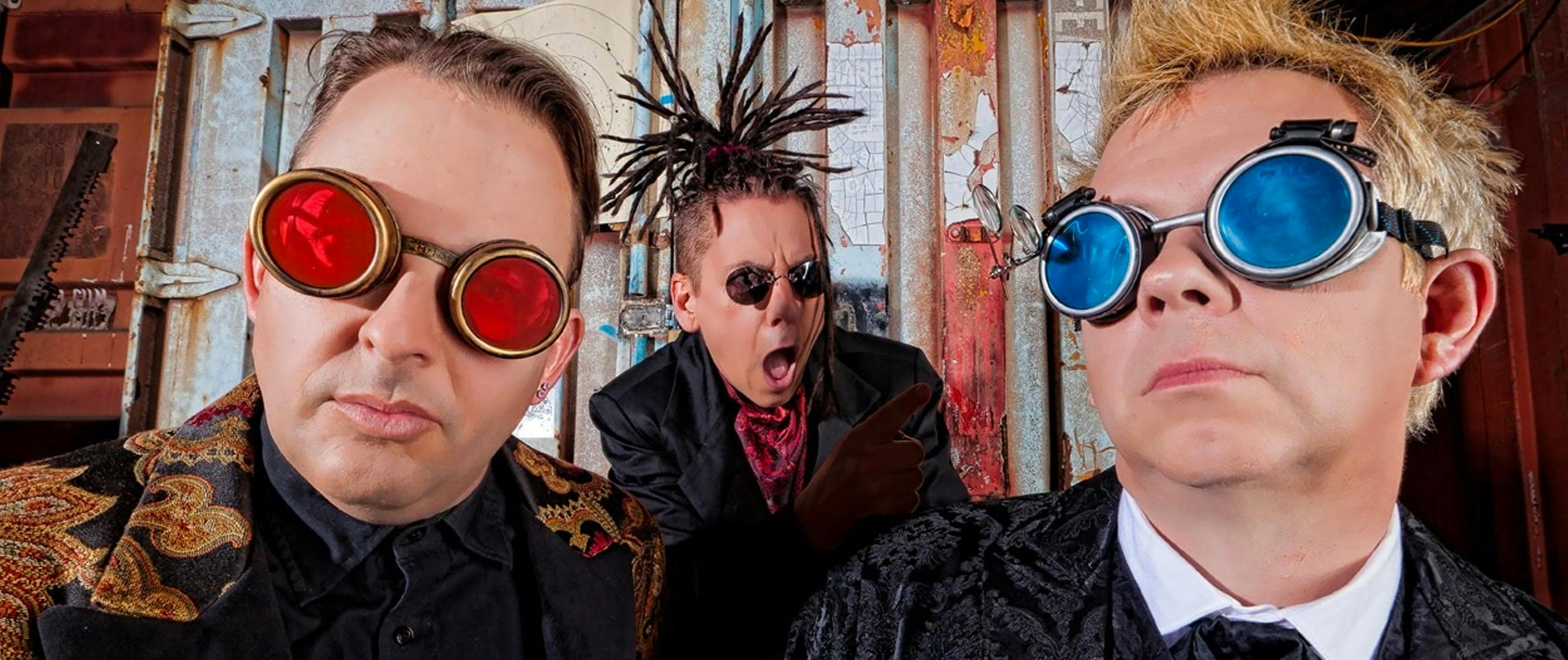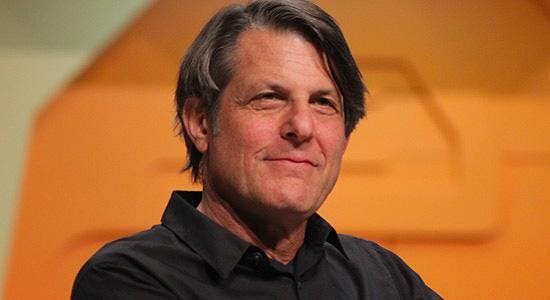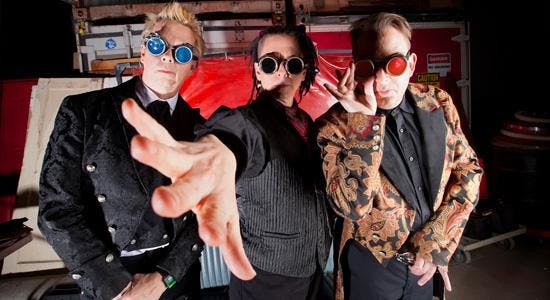Published Dec 23, 2017
Kurt Larson of Information Society Talks Trek Cruise II
Kurt Larson of Information Society Talks Trek Cruise II

The year was 1988. Information Society, an electronic music band out of Minneapolis, released their eponymous first major-label album, and it exploded onto the charts on the strength of its lead single, “What’s on Your Mind (Pure Energy).” That song sampled dialogue from Star Trek: The Original Series, specifically a Leonard Nimoy/Spock snippet from “Errand of Mercy” and a DeForest Kelley/Dr. McCoy bit from “I, Mudd.” Music lovers all around the world got their groove on to the tune, and it reached #1 on the U.S. Dance Music/Club Play chart and #3 on the Billboard U.S. Hot 100 chart. Fans also heard Star Trek samples on three other InSoc songs from that album, “Over the Sea, “Walking Away” and "Something in the Air."
Now, nearly 30 years later, those songs remain incredibly entertaining and have paved the way for Information Society – which consists of co-founders Kurt Larson and Paul Robb, and James Cassidy – to perform aboard both legs of Star Trek: The Cruise II when the Norwegian Jade sets sail in a couple of weeks. StarTrek.com recently chatted with Kurt Larson, who filled us in on the creation of “What’s on Your Mind,” detailed how Adam and Leonard Nimoy helped secure the Trek samples, and previewed InSoc’s plans for Star Trek: The Cruise II.
What are you doing these days, and what has the band been up to in terms of recording/gigs?
We had our heyday back in the late 80's, early 90's when we were Warner Brothers recording artists. That was when the band was our fulltime job for all three of us. Then we came to our senses in the mid-90's and went our separate ways, got real jobs. We didn't do much of anything with the band for some years and then, mid 00's, we started playing shows again on a one-off basis. The last decade-plus, it's been more of a hobby, something we do for a little extra money and just to do some fun things.
We'll do, maybe, a show every two or three months, and we put out albums in 2006, then another one around 2012, 2014, and we're working on some new music now. But, it's relaxed. We're not depending on this to pay our rent anymore, so we don't hurry and don't have any specific plans. We just take things as they come.
We’ve read/heard many descriptions of InSoc’s music: pop, techno, synth pop, new wave, etc. How would you classify the band's sound?
Classify... I'll take that world literally. Into which class does it go? With any band, I think of it as a Venn diagram. We're at the intersection of what you'd call pop music and synth music, or synth pop music, and dance music. Then, there's this other circle in there that's hard to place, this thread of an irreverent, Avant Garde sense of humor about everything.

Take us through the creation of “What's on Your Mind”...
Its origins were in mid-1986. Paul had a song he was working on, then we had this original demo, which I still have. I actually still have a recording of that. We made some changes. He had the chorus down fairly well, but it was a whole different set of words. Originally, it was, "So tell me what you're thinking/Say what's on your mind/For surely we have time, girl/To say what's on your mind." That was the original chorus. I went over the lyrics, added the verse lyrics and he changed the chorus lyrics. We played it for our label, which was Tommy Boy at the time, and our manager. They said, "Eh, it's OK. Can you make some changes?" Paul spruced it up again. Now, we're getting into 1987. We tried to record it in a studio in Minneapolis, and we were still so inexperienced. We didn't have the help of a top-notch producer yet, so we gave that to them and they went, "Eh, why don't you come to New York and we'll get you a real producer?"
Then, in the summer of '87, we were working in New York on the real version of it, with the man who eventually produced our first album, Fred Maher, who’d just come off working with Kraftwerk. He’d worked heavily with Scritti Politti. We went into that song, and he's the one who knew how to make it into something cool. Then, we had this first unmixed version with him, but it still really wasn't there yet. If you heard it, you'd go, "Wow, this isn't the song I know." We got this guy to do the mix, Roey Shamir. Fred and he brought that thing up into becoming what it eventually became.
That was the phase when we did the two signature sounds in that song. We added the Star Trek samples; probably the most-important thing for making it memorable. Also, that's when we came up with this technique to do what people think of as sampled guitars, which they're not. There are no guitar sounds, not even sampled guitars. We had this section with straight synthesizer string parts, in the background, and it's boring. I said, "Can't we spruce this up, make it sound a little more aggressive, have more edge?" We ran the synthesizers through a distortion box and, basically, that turned it into that fast, staccato rhythm that sounds a little bit reminiscent of somebody scrubbing a guitar. Those two things, which came together at the very end, were the last steps in turning it into the song we now know.
Who was the Trek fan in the group?
I was the most intense Trek fan, and it was my idea to get all the little Trek recordings, which we did before we even had samplers. I had this old cassette deck I connected directly via cable to the output of my old television. This was 1985. I recorded hours of Star Trek. When we got samplers, I went over those tapes and recorded them back off the cassette tapes into the samplers, tiny bits of speech, like "Let's go see" and Spock saying, "Pure energy." We had those samples ready. We weren't sure what we’d use them for, but then, when we were in the studio and the time came, we thought, "Hey, let's add those in."

Our understanding is that Adam Nimoy played a key role in securing the rights to the Trek samples…
For me, that’s one of the most interesting bits of Information Society lore. We finally finished mixing and recording the album in '87, but that was a very scary time for labels around the concept of digital sampling. A lot of arguing was going on legally. "Is this OK?" You had stuff like Vanilla Ice taking that bit from the Queen song a couple of years later, which itself was ripped off from another song. There was a lot of stuff going on with rap, in the hip hop community, with scratching, meaning you put a scratch on the record and allowed it to get into a loop, and then start talking over that. They didn't feel like they were plagiarizing. It was a whole new art form to them. But from the point of view of intellectual property lawyers who think, "Hey, that's our stuff, you can't do that," it was a chaotic time and the labels were frightened.
One day at Warner Brothers, somebody noticed, "Hey, this song's got Paramount's property all over it. Paramount's not going to allow us to do this. Oh, my God." So, they didn't release the album. They sat on it. They didn't know what to do. The album languished for months. Our representative at Warner Bros. kept trying to make this happen, saying, "Just call Paramount, offer them some money for the use of their little speech clips from Star Trek, and we'll be fine." Paramount... what interest did they have in doing that? You got somebody working at Paramount who gets this weird-ass letter or phone call from somebody saying, "Hey, we want to pay you some money to use a bunch of clips from your Star Trek property in our weird-ass dance album." Well, the person with that job says, "Hmm, if I just don't do anything, there's no risk to me. If I say yes, I might get fired." So obviously, nothing was going to happen.
That went on for almost nine months. But by one of those points of bizarre, unpredictable luck, our rep at Warner Brothers, Kevin Laffey, was friends with Adam Nimoy, who at the time was a music business lawyer in Los Angeles. Our rep called Adam and said, "Can you help? Can you talk to your dad? Does he have any pull at Paramount?" Adam took this to Leonard. Even though at the time their relationship was kind of strained, he took this to his dad and said, "Dad, can you help me out with this? Can you talk to people at Paramount? Warner Brothers will give Paramount money, you give Warner Brothers permission, and that's it. No one has to do anything else." Leonard took it to Paramount and said, "Hey guys, can you do this?" And they did. That cleared the way. It was only when Leonard himself intervened on our behalf, that our first album came out.
You weren’t sure, for a while, if this story was true, right?
I wondered for a long time whether the way it was told to me was really the way it happened, because it sounded a little fluffed-up to make it more interesting. About 15 years later, I was lucky enough to meet Leonard Nimoy in San Francisco, where I live now ... because he was there promoting his photography book, Shekhina. We talked for half an hour because he was there with no one around him ... which I couldn't believe. I said, "Hey, I've always been told this thing about how you did this for our album and I always wondered if that was true." He thought for a minute and said, "Oh, yes. I do recall that. Adam brought that to me. Did that album ever come out?" So, he'd never heard it. Nimoy is the only member of the original cast I ever got to meet, although if I'm lucky I'll get to say hi to George Takei on the cruise.

How did the cruise folks approach you to appear on The Cruise II and what was the band's reaction?
Well, they stood there and cringed while we jumped up and down around them saying, "Can we do the Star Trek Cruise? Can we do the Trek Cruise, please? We'll be your best friend." We knew them because they organized the 80's Cruise. We did that in February, and that went down pretty well, and during that time our manager spoke with them and said, "Hey the band would love to do a Star Trek Cruise, because they're all over that stuff." Some months later, they worked it out and here we are.
Our understanding is you plan to "Trek-ify" some classic InSoc songs…
I'm working on that now. We have some Trek samples we played during some of our songs, but let's just say there's room for a whole lot more. Whereas a song might’ve had one, now it'll probably have 10 ... and whereas before it didn't have any, now it'll probably have 10. We're going to play our special version of “What's on Your Mind” that we did as a tribute to Leonard Nimoy right after he died, that has an extra section in the middle all about him. And, if Paul lets me, if he can stand to listen to me go on and on like I do onstage, I want to take a few moments to say some things retrospectively about what Trek has meant to me and the band. Oh, and also there are costumes. We’ve got some special costumes. And there could be a couple of other surprises, too.
For details about Information Society, visit www.informationsociety.com. And for information about Star Trek: The Cruise II, visit www.startrekthecruise.com.

